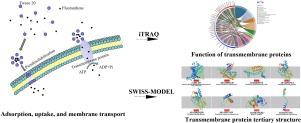Journal of Hazardous Materials ( IF 12.2 ) Pub Date : 2020-08-19 , DOI: 10.1016/j.jhazmat.2020.123707 Ruhan Jiang , Xiaoxiong Wu , Yaqian Xiao , Dekang Kong , Yi Li , Hongqi Wang

|
Polycyclic aromatic hydrocarbons (PAHs) are degraded by the highly efficient degrading bacterium Bacillus cereus. Transmembrane transport is highly important in PAH degradation by bacteria. Surfactants are the key substances that promote PAH adsorption, uptake and transmembrane transport by Bacillus cereus. In this study, the isobaric tags for relative and absolute quantitation (iTRAQ) approach was used for high-throughput screening of key functional proteins during transmembrane fluoranthene transport by Bacillus cereus treated with Tween 20. In addition, SWISS-MODEL was used to simulate the tertiary structures of key transmembrane proteins and analyze how Tween 20 promotes transmembrane transport. Transmembrane fluoranthene transport into Bacillus cereus requires transmembrane proteins and energy. Tween 20 was observed to improve bacterial motility and transmembrane protein expression. The interior of representative transmembrane proteins is mostly composed of hydrophobic β-sheets while amphipathic α-helices are primarily distributed at their periphery. The primary reason for this configuration may be α-helices promote the aggregation of surfactants and the phospholipid bilayer and the β-sheets promote surfactant insertion into the phospholipid bilayer to enhance PAH transport into Bacillus cereus. Investigating the effect of Tween 20 on Bacillus cereus transmembrane proteins during transmembrane fluoranthene transport is important for understanding the mechanism of PAH degradation by microorganisms.
中文翻译:

吐温20调节蜡样芽孢杆菌跨膜蛋白的功能和结构:促进荧蒽的跨膜运输。
多环芳烃(PAHs)被高效降解的蜡状芽孢杆菌(Bacillus cereus)降解。跨膜运输在细菌降解PAH中非常重要。表面活性剂是促进蜡状芽孢杆菌吸附PAH,吸收和跨膜运输的关键物质。在这项研究中,采用等压相对和绝对定量(iTRAQ)方法,通过吐温20处理的蜡状芽孢杆菌在跨膜荧蒽转运过程中,对关键功能蛋白进行高通量筛选。此外,SWISS-MODEL用于模拟跨膜蛋白的三级结构,并分析Tween 20如何促进跨膜运输。跨膜荧蒽转移进入蜡状芽孢杆菌需要跨膜蛋白和能量。观察到吐温20可改善细菌运动性和跨膜蛋白表达。代表性跨膜蛋白的内部主要由疏水性β-折叠组成,而两亲性α-螺旋主要分布在其外围。这种构型的主要原因可能是α-螺旋促进了表面活性剂的聚集和磷脂双层,而β-折叠促进了表面活性剂插入磷脂双层中以增强PAH向蜡样芽胞杆菌的转运。研究吐温20对蜡状芽孢杆菌的作用 跨膜荧蒽转运过程中的跨膜蛋白对于理解微生物降解PAH的机制很重要。








































 京公网安备 11010802027423号
京公网安备 11010802027423号